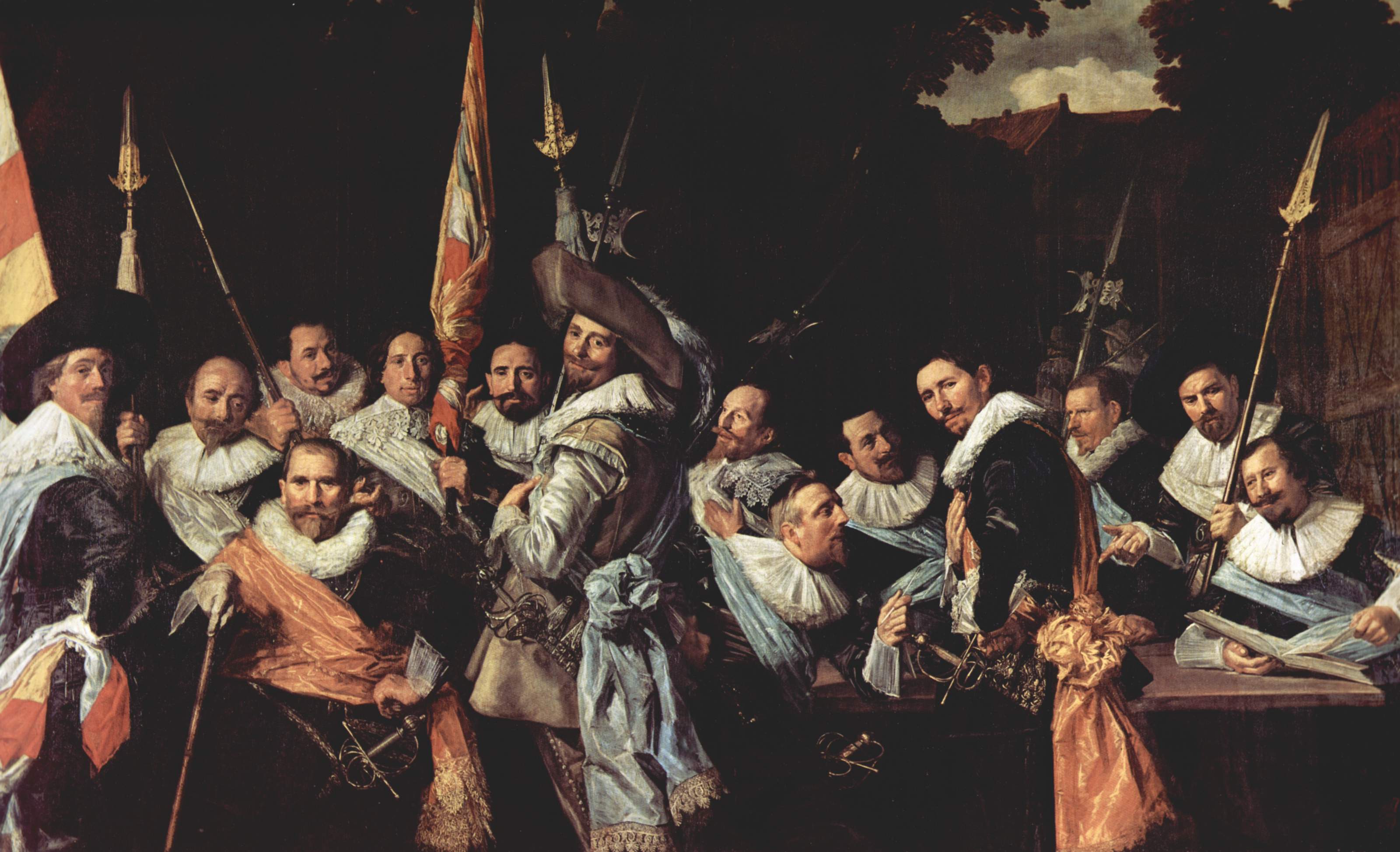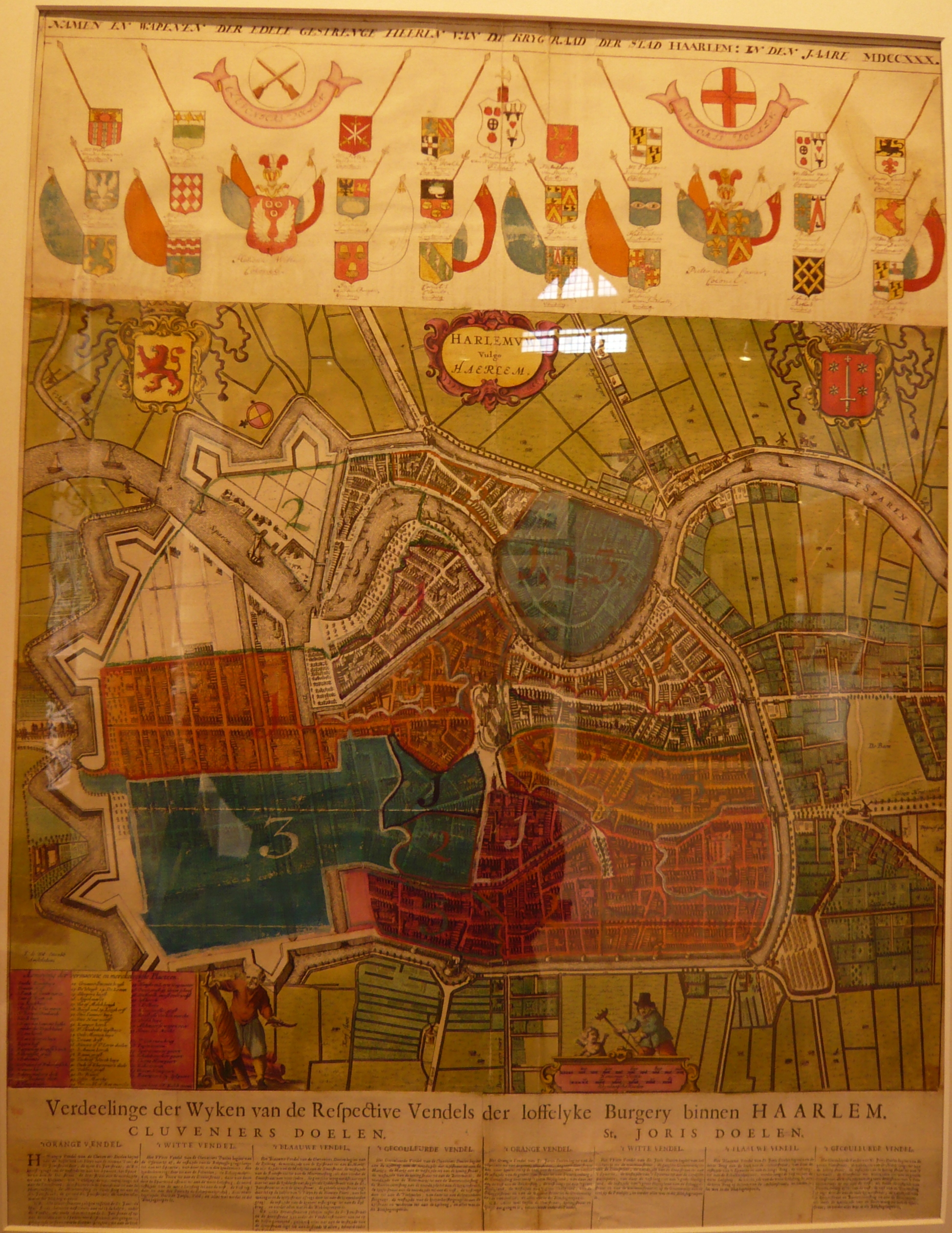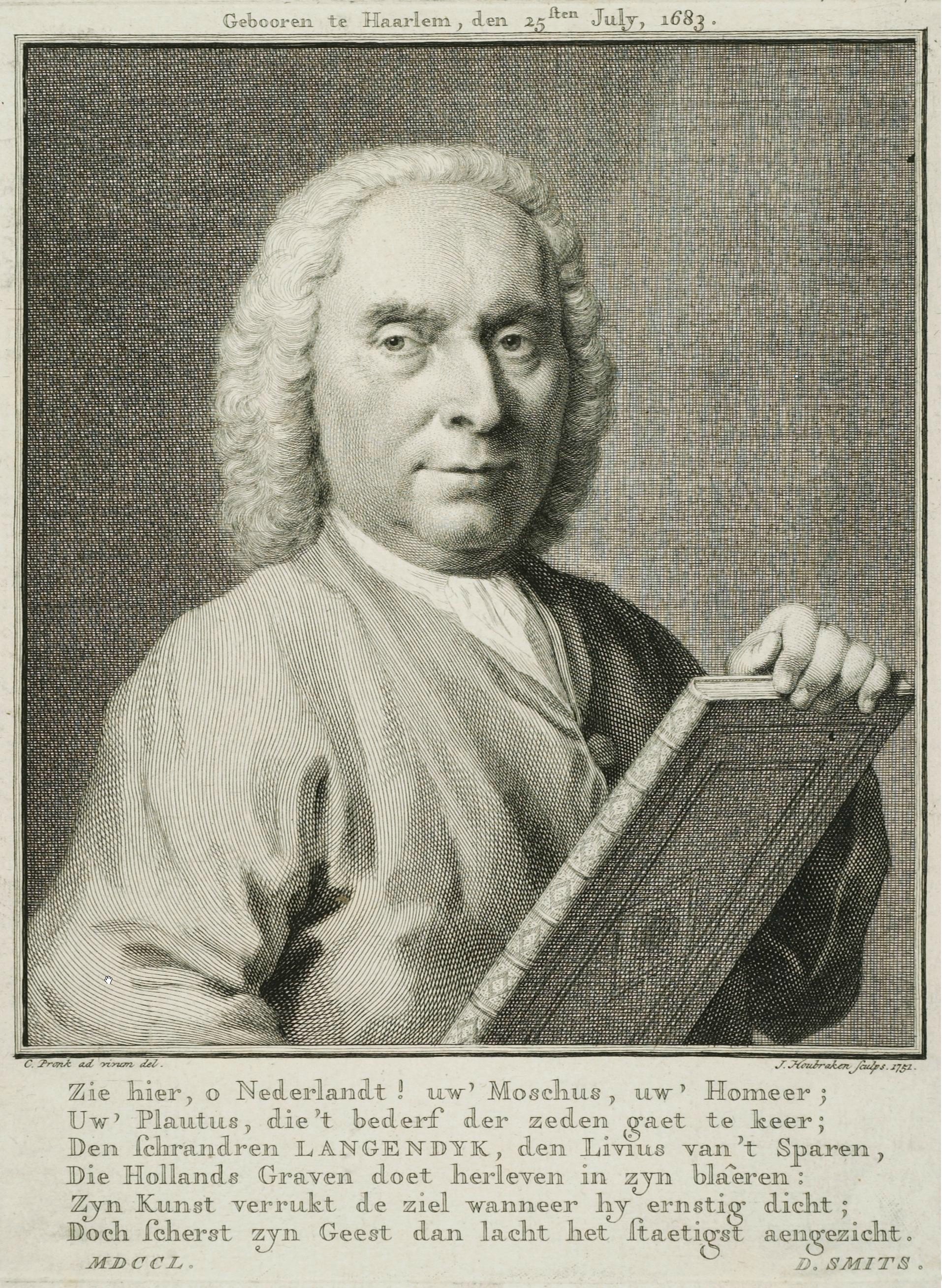|
Proveniershuis
The Proveniershuis is a hofje and former schutterij on the Grote Houtstraat in Haarlem, Netherlands. The complex of buildings surrounds a rectangular garden taking up a city block that is on the Haarlem hofje route. Unlike hofjes that were meant for poor elderly women, the homes around this courtyard are much larger, and the garden itself is about twice the normal size. The reason is that these inhabitants were men who actually paid rent to live there, as opposed to hofje inhabitants who had no income to spend on rent. Most hofjes were for women, because they were able to run their own modest household, usually as a member of a "hofje team" in various responsible roles. Men were generally less able to take care of themselves and were thus dependent on the "preuves" in the form of simple meals and services that were paid for from rents. History This home for Haarlem ''proveniers'' was founded in 1707 by the city council to house elderly men. The main buildings are much older than ... [...More Info...] [...Related Items...] OR: [Wikipedia] [Google] [Baidu] |
The Banquet Of The Officers Of The St George Militia Company In 1616
''The Banquet of the Officers of the St George Militia Company in 1616'' refers to the first of several large schutterstukken painted by Frans Hals for the St. George (or St. Joris) civic guard of Haarlem, and today is considered one of the main attractions of the Frans Hals Museum there. Influenced by Cornelis van Haarlem Hals was in his thirties when he painted this piece, and was far from established as a portrait painter. To be safe, he based most of his design on the painting of his predecessor, Cornelis Cornelisz van Haarlem, who painted the same militia company in 1599. Given a nearly impossible task, namely to complete his assignment but to add theatrical elements at the same time, Hals must have spent much time judging the politics of the group. He knew these men well as he served in the St. Joris militia himself from 1612–1615. In his painting, he indicates the political position of each man in the group as well as managing to give each a characteristic portrait. ... [...More Info...] [...Related Items...] OR: [Wikipedia] [Google] [Baidu] |
Frans Hals Museum
The Frans Hals Museum is a museum located in Haarlem, the Netherlands. The museum was established in 1862. In 1950, the museum was split in two locations when the collection of modern art was moved to the '' Museum De Hallen'' (since 2018 called ''Hal)''. The main collection, including its famous 17th-century Frans Hals paintings, for which the museum is named, is located in the former ''Oude Mannenhuis'' on the Groot Heiligland. The museum was founded in 1862 in the newly renovated former Dominican church cloisters located in the back of the Haarlem city hall known as the ''Prinsenhof'', and when it needed more space, it moved to the recently vacated location of the town orphanage in 1913. The collection is based on the large number of paintings owned by the City of Haarlem, which includes over 100 artworks seized from Catholic churches in the 1580s after the Protestant Reformation, and Haarlem art rescued from demolished local buildings from the 15th century onwards. In 2018 t ... [...More Info...] [...Related Items...] OR: [Wikipedia] [Google] [Baidu] |
Grote Houtstraat
The Grote Houtstraat is a shopping street in Haarlem that connects the Grote Markt to the Houtplein in the direction of the Haarlemmerhout woods. History The street runs along one of two old parallel roads running through the city on either side of the Grote Markt linking Heemstede to Schoten, and is one of the oldest streets in Haarlem. The Grote Houtstraat in Haarlem was originally just called the "Houtstraat" (Wood street) as it was the major road leading from the Grote Markt to the woods called the Haarlemmerhout.De straat waarin wij in Haarlem wonen; geschiedenis en verklaring der Haarlemse straatnamen, G. H. Kurtz, 1965 Until the 15th century it ended at what is today the , at that time the southern canal of the city. In the 15th century the town expanded southwards and the street was extended to the and a large town gate was placed near the bridge, which has since been torn down. Shopping street The street is lined with rijksmonuments such as the Verwey Hall, the Do ... [...More Info...] [...Related Items...] OR: [Wikipedia] [Google] [Baidu] |
The Banquet Of The Officers Of The St George Militia Company In 1627
''The Banquet of the Officers of the St George Militia Company in 1627'' refers to a schutterstuk painted by Frans Hals for the St. George (or St. Joris) civic guard of Haarlem, and today is considered one of the main attractions of the Frans Hals Museum there. In this group, each man wears a sash belonging to the color of the "rot", in this painting all three are represented with their flag-bearers wearing the colours Orange, white or blue. These officers were selected by the council of Haarlem to serve for three years, and this group had just finished their tenure and celebrated their end of service with a portrait. The man with the orange sash holding a glass of wine sitting at the table on the left and looking at Captain Michiel de Wael with an empty glass, is Colonel Aart Jansz Druyvesteyn, who heads the table. The men featured are from left to right Lieutenant Cornelis Boudewijns (standing above Colonel Aernout Druyvesteyn), Captain Nicolaes Verbeek, Flag bearer Boude ... [...More Info...] [...Related Items...] OR: [Wikipedia] [Google] [Baidu] |
Lieven De Key
Lieven de Key (1560 – 17 July 1627) was a Dutch renaissance architect in the Netherlands, mostly known today for his works in Haarlem. His style is described by Simon Schama as Mannerist. Biography De Key was born in Ghent, and was already a well-known architect when the Haarlem council invited him to become city architect in 1592 to succeed Wouter den Abt. He brought to Haarlem the same Dutch renaissance style that Hendrick de Keyser brought to Amsterdam. Everything attributed to him or his followers, whether a building, a doorway, or merely a gable stone, is considered a rijksmonument today. The reason so many buildings in Haarlem can be attributed to him is because Haarlem had suffered a severe fire in 1576 that destroyed a third of the city, and plans were underway for large city projects when he was appointed city architect. Before working in Haarlem and Leiden, De Key had worked in London from 1580–1591. [...More Info...] [...Related Items...] OR: [Wikipedia] [Google] [Baidu] |
Haarlem Schutterij
The Haarlem schutterij refers to a collective name for the voluntary civic guard of Haarlem, from medieval times up to the Batavian Revolution in 1794, when the guilds of Haarlem were disbanded. History During the Hook and Cod wars in 1402, Haarlem formed a hand bow schutterij under the patronage of St. George of 120 citizen volunteers to support the local court of Justice. The guild-like group had its own altar in the St. Bavochurch and they even had processions through town on the name day of their saint. The town suffered from uprisings in 1417 and 1422. After another uprising in 1425, a "New" schutterij was formed to educate young men in the use of the crossbow and they defended the city in 1426 against Jacoba of Beieren. The "New" crossbow schutterij had a new meeting hall built for them near the Spaarne river, and in 1468 a separate schutterij was formed under the patronage of St. Sebastian for hand bowmen. Around 1500 Haarlem had three schutterij groups, two (old and n ... [...More Info...] [...Related Items...] OR: [Wikipedia] [Google] [Baidu] |
Daniel Cajanus
Daniel Cajanus (1704 – 27 February 1749) was a Finnish giant. He made his living by exhibiting himself for money; he appeared in many European countries and attracted the interest of scientists and laypeople, including royalty. After his death, portions of his skeleton found their way into museums, where some parts still remain. Biography Cajanus was born in Paltamo, Oulu, Finland, the son of a clergyman. His Latinized surname might been derived from the name of the town of Kajaani or the region of Kainuu, which was also known its Latin name "Cajania". Finland was at that time part of Sweden, and Cajanus was often referred to as the "Swedish Giant". Estimates of his adult height vary and range as high as . Jan Bondeson, a medical professional and author who has researched and written on Cajanus, suggests that his true height was around , supported by contemporaneous accounts in the ''London Annual Register''. Various unconfirmed versions of his early life exist, but tax records ... [...More Info...] [...Related Items...] OR: [Wikipedia] [Google] [Baidu] |
Pieter Langendijk
Pieter Langendijk (Haarlem, 25 July 1683 – Haarlem, 9 or 18 July 1756) was a damask weaver, city artist, dramatist, and poet. Life Pieter was the son of Arend Kort, a mason born in Langedijk. His father died in 1689 so he temporarily came under the protection of the Amsterdam poet William Sewell.Pieter Langendijk in "De Nederlandse en Vlaamse auteurs", by G.J. van Bork and P.J. Verkruijsse, De Haan, Weesp 1985, in the DBNL In 1695, they moved to and his mother began a linen business. Pieter became a weaver and pattern draughtsman and join ... [...More Info...] [...Related Items...] OR: [Wikipedia] [Google] [Baidu] |
The Officers Of The St George Militia Company In 1639
''The Officers of the St George Militia Company in 1639'' refers to the last and largest schutterstuk painted by Frans Hals for the St. George (or St. Joris) civic guard of Haarlem, and today is considered one of the main attractions of the Frans Hals Museum there. In this painting over 4 meters wide, nineteen men are portrayed, each wearing a sash in the color of his "rot", or brigade. All three brigades of the St George militia are represented, with their flag-bearers carrying flags in the colours orange, white or blue. These officers were selected by the council of Haarlem to serve for three years, and this group had just finished their tenure and celebrated their end of service with a portrait. The man with the commander's staff situated third from lower left with the orange sash and orange feather in his hat is the Colonel Johan Claesz Loo, who heads the militia. The other officers are carrying partisans with tassles (captains), spontoons (lieutenants) or halberds (serg ... [...More Info...] [...Related Items...] OR: [Wikipedia] [Google] [Baidu] |
Sint-Bavokerk
The Grote Kerk or St.-Bavokerk is a Reformed tradition, Reformed Protestant church and former Catholic cathedral located on the central market square (Grote Markt (Haarlem), Grote Markt) in the Netherlands, Dutch city of Haarlem. Another Haarlem church called the Cathedral of Saint Bavo now serves as the main cathedral for the Roman Catholic Diocese of Haarlem-Amsterdam. History This church is an important landmark for the city of Haarlem and has dominated the city skyline for centuries. It is built in the Gothic architecture, Gothic style of architecture, and it became the main church of Haarlem after renovations in the 15th century made it significantly larger than the Janskerk (Haarlem). First mention of a church on this spot was made in 1307, but the wooden structure burned in the 14th century.Rijksmonument report The church was rebuilt and promoted to chapter church in 1479 and only became a cathedral in 1559. The main architects were Godevaert de Bosscher and Steven van Affl ... [...More Info...] [...Related Items...] OR: [Wikipedia] [Google] [Baidu] |
Garrison
A garrison (from the French ''garnison'', itself from the verb ''garnir'', "to equip") is any body of troops stationed in a particular location, originally to guard it. The term now often applies to certain facilities that constitute a military base or fortified military headquarters. A garrison is usually in a city, town, fort, castle, ship, or similar site. "Garrison town" is a common expression for any town that has a military base nearby. "Garrison towns" ( ar, أمصار, amsar) were used during the Arab Islamic conquests of Middle Eastern lands by Arab-Muslim armies to increase their dominance over indigenous populations. In order to occupy non-Arab, non-Islamic areas, nomadic Arab tribesmen were taken from the desert by the ruling Arab elite, conscripted into Islamic armies, and settled into garrison towns as well as given a share in the spoils of war. The primary utility of the Arab-Islamic garrisons was to control the indigenous non-Arab peoples of these conque ... [...More Info...] [...Related Items...] OR: [Wikipedia] [Google] [Baidu] |
Frans Decker
Frans Decker (1684 – 1751) was an 18th-century painter from the Northern Netherlands. Biography Decker was born in 1684. He was a painter whose pictures possess great merit, and are to be met with in almost every collection. He is stated to have been born at Haarlem in 1684, and to have died at the same place in 1751, having been a pupil of Romeyn De Hooghe and of Bartholomeus Engels.Frans Decker in the He painted landscapes in a very pleasing and natural style, resembling the charming productions of Ruisdael, but without the servility of an imitator. He also excelled in caricature. H ... [...More Info...] [...Related Items...] OR: [Wikipedia] [Google] [Baidu] |

_-_WGA11053.jpg)









.png)